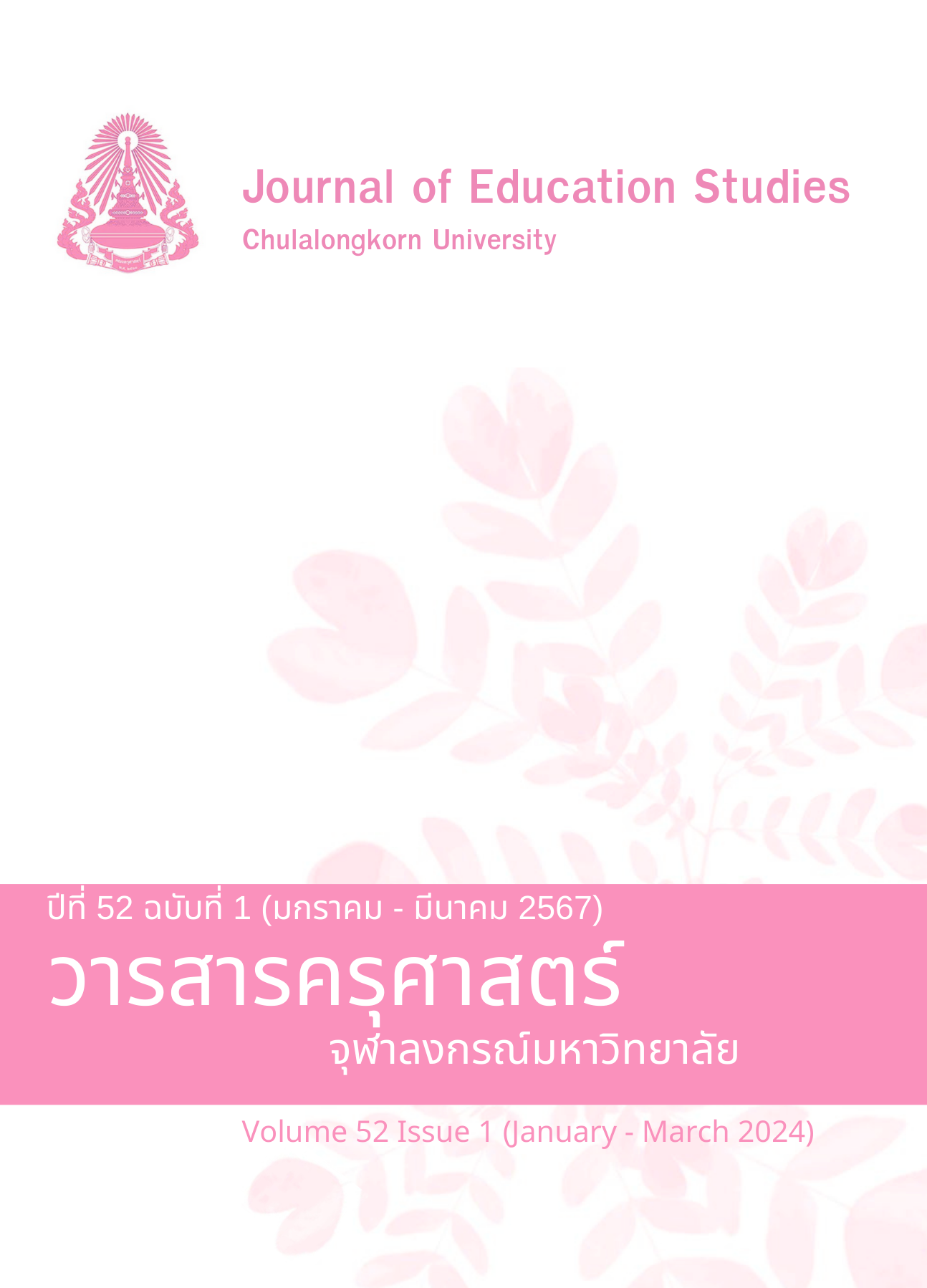The Development of Online Music Lessons Using a Flipped Classroom on the Principles and Methods of Singing Thai Songs for Elementary School Students
DOI:
https://doi.org/10.14456/educu.2024.17Keywords:
online music lessons, flipped classroom, Thai singing principles and methodsAbstract
The objectives of this research were: 1) to develop and determine the effectiveness of online music lessons using the flipped classroom model; 2) to compare the academic achievement of students before and after learning with online music lessons under the flipped classroom model; and 3) to assess students’ satisfaction with online music lessons using a flipped classroom. This research is pre-experimental research using one group pretest-posttest design. The sample group were 20 sixth grade students from Bannonglee Witthayakhom School in 2023 academic year. The tools used in the research included online music lessons involving the singing of Thai songs, comprising 10 lessons, as well as pre- and post-class tests, a practical skills assessment form, a learning evaluation based on the actual conditions, and a satisfaction assessment. Statistics used in data analysis included mean, standard deviation, t-test, and efficiency test according to the criterion E1/E2 = 80/80. The research results found that: 1) online music lessons using the flipped classroom model had an efficiency of 80.32/83.75, which is in accordance with the specified criteria; 2) post-study achievement learned from online music lessons using the flipped classroom model recorded higher scores than before learning at
a statistically significant level of 0.05; and 3) satisfaction with learning the activities was found to be at a very good level.
References
ภาษาไทย
กิตติภัค วรชินา, สุริยะ วชิรวงศ์ไพศาล, ดรุณี ปัญจรัตนากร, และ พงษ์ศักดิ์ ผกามาศ. (2566). การพัฒนาแพลตฟอร์มการจัดการเรียนรู้ออนไลน์วิชาดนตรีโดยใช้เทคนิคของโคดายร่วมกับการเรียนรู้ร่วมกันสำหรับนักเรียนชั้นประถมศึกษาปีที่ 6. วารสารการศึกษาและนวัตกรรมการเรียนรู้, 3(1), 53-70.
ทิศนา แขมมณี. (2563). ศาสตร์การสอน: องค์ความรู้เพื่อการจัดกระบวนการเรียนรู้ที่มีประสิทธิภาพ. (พิมพ์ครั้งที่ 24). สำนักพิมพ์แห่งจุฬาลงกรณ์มหาวิทยาลัย.
บุญชม ศรีสะอาด. (2560). การวิจัยเบื้องต้น. พิมพ์ครั้งที่ 10. สุวีริยาสาส์น.
เบญจพร ตีระวัฒนานนท์. (2563). การพัฒนาบทเรียนออนไลน์ตามแนวคิดห้องเรียนกลับด้าน เรื่อง การสร้างภาพกราฟิกโดยโปรแกรมนำเสนอ สำหรับนักเรียนชั้นประถมศึกษาตอนปลาย. [วิทยานิพนธ์การศึกษามหาบัณฑิต, มหาวิทยาลัยบูรพา]. web opac. https://digital_collect.lib.buu.ac.th/dcms/files/58920713.pdf.
พระราชบัญญัติการศึกษาแห่งชาติ พ.ศ. 2542 ที่แก้ไขเพิ่มเติม (ฉบับที่ 3) พ.ศ. 2553. (2553, 22 กรกฎาคม). ราชกิจจานุเบกษา. เล่ม 127 ตอนที่ 45 ก. หน้า 1-3.
พระมหาจักรพล สิริธโร. (2564). การศึกษาในยุค New Normal. Journal of Modern Learning Development, 6(6), 346-356.
พิชิต ฤทธิ์จรูญ. (2556). หลักการวัดและประเมินผลการศึกษา. (พิมพ์ครั้งที่ 8). บริษัท เฮ้าส์ ออฟ เคอร์มิสท์ จํากัด.
ภากร เทียนทิพย์การุณย์. (2561). การศึกษาผลการเรียนรู้ตามแนวคิดห้องเรียนกลับด้านร่วมกับการจัดการเรียนรู้ที่เน้นการพัฒนาทักษะการปฏิบัติ หน่วยการเรียนรู้ ขลุ่ยบรรเลงเพลงเสนาะ ของนักเรียนชั้นมัธยมศึกษาปีที่ 3. [วิทยานิพนธ์ครุศาสตรมหาบัณฑิต, มหาวิทยาลัยราชภัฏนครราชสีมา]. ThaiLIS. https://tdc.thailis.or.th/tdc/search_result.php.
รัชนู พิมพิทักษ์. (2560). ทักษะการปฏิบัติงานศิลปะ และความใฝ่รู้ใฝ่เรียนของนักเรียน ชั้นมัธยมศึกษาปีที่ 1 โรงเรียนสวนกุหลาบวิทยาลัย ที่เรียนรู้ด้วยการจัดการเรียนรู้แบบห้องเรียนกลับด้าน และการจัดการเรียนรู้แบบสาธิต. [วิทยานิพนธ์มหาบัณฑิต, มหาวิทยาลัยราชภัฏธนบุรี]. ThaiLIS. https://tdc.thailis.or.th/tdc/search_result.php.
วิจารณ์ พานิช. (2557).ครูเพื่อศิษย์สร้างห้องเรียนกลับทาง. (พิมพ์ครั้งที่ 2). บริษัท เอส. อาร์. พริ้นติง แมสโปรดักส์ จำกัด.
ศิริชัย กาญจนวาสี. (2552). ทฤษฎีการทดสอบแบบดั้งเดิม. (พิมพ์ครั้งที่ 6). โรงพิมพ์แห่งจุฬาลงกรณ์มหาวิทยาลัย.
สำนักงานเลขาธิการสภาการศึกษา. (2565). มาตรการฟื้นฟูภาวะถดถอยทางการเรียนรู้. บริษัท เอส. บี. เค. การพิมพ์ จำกัด.
สุธาสินี ถีระพันธ์. (2566). การพัฒนารูปแบบการเรียนการสอนรายวิชาปฏิบัติทักษะดนตรีออนไลน์สำหรับนิสิตระดับปริญญาตรี วิทยาลัยดุริยางคศิลป์ มหาวิทยาลัยมหาสารคาม. วารสารมนุษยศาสตร์และสังคมศาสตร์ มหาวิทยาลัยนครพนม, 19(1), 173-188.
อนุธิดา เดชแฟง. (2562). การจัดการเรียนรู้แบบห้องเรียนกลับด้าน ผ่าน Facebook ร่วมกับการ เรียนรู้แบบเครื่องมือการคิด เพื่อพัฒนาทักษะกาคิดวิเคราะห์ สำหรับนักเรียนชั้นมัธยมศึกษาปีที่ 2 โรงเรียนเทศบาลวัดไทยชุมพล (ดำรงประชาสรรค์). [วิทยานิพนธ์ครุศาสตรมหาบัณฑิต, มหาวิทยาลัยราชภัฏพิบูลสงคราม]. ThaiLIS. https://tdc.thailis.or.th/tdc/search_result.php.
อนุศร หงส์ขุนทด. (2558). การพัฒนารูปแบบระบบการเรียนแบบห้องเรียนกลับด้านผ่านสื่อ 3 แบบ ด้านทักษะดนตรีสำหรับนักเรียนชั้นมัธยมศึกษา. [วิทยานิพนธ์ปรัชญาดุษฎีบัณฑิต, มหาวิทยาลัยเกษตรศาสตร์]. ThaiLIS. https://tdc.thailis.or.th/tdc/search_result.php.
ภาษาอังกฤษ
Bloom, B. S., et al. (1956). Taxonomy of Educational Objectives: Cognitive and Affective Domains. David McKay.
Downloads
Published
How to Cite
Issue
Section
License

This work is licensed under a Creative Commons Attribution-NonCommercial-NoDerivatives 4.0 International License.




